Unit - 6
Electrical Installations
Switchgear
The apparatus used for switching, controlling and protecting the electrical circuits and equipment is known as switchgear. The term ‘switchgear’ is a generic term encompassing a wide range of products like circuit breakers, switches, switch fuse units, off-load isolators, HRC fuses, contactors, earth leakage circuit breaker, etc.
Classification of Switchgear:
Switchgear can be classified on the basis of voltage level into the following:
1. Low voltage (LV) Switchgear: upto 1KV
2. Medium voltage (MV) Switchgear: 3 KV to 33 KV
3. High voltage (HV) Switchgear: Above 33 KV
Components of LT Switchgear:
The term LT Switchgear includes low voltage Circuit Breakers, Switches, off load electrical isolators, HRC fuses, Earth Leakage Circuit Breaker, Miniature Circuit Breakers (MCB) and Molded Case Circuit Breakers (MCCB) etc i.e. all the accessories required to protect the LV system. The most common use of LV switchgear is in LV distribution board.
FUSE:
Fuse is perhaps the simplest and cheapest device used for interrupting an electrical circuit under short circuit, or excessive overload, current magnitudes. The action of a fuse is based upon the heating effect of the electric circuit.
The part which actually melts and opens the circuit is known as the fuse element. Fuses have following advantages and disadvantages:
Advantages:
- It is cheapest form of protection available.
- It needs no maintenance.
- Its operation is inherently completely automatic unlike a circuit breaker which requires an elaborate equipment for automatic action.
- It interrupts enormous short circuit currents without noise, flame, gas or smoke.
Disadvantages:
- Considerable time is lost in rewiring or replacing a fuse after operation.
- On heavy short circuits, discrimination between fuses in series cannot be obtained unless there is considerable differences in the relative sizes of the fuse concerned.
- The current-time characteristics of a fuse cannot always be correlated with that of the protected device.
The various types of fuse units, most commonly available are:
- Round type fuse unit.
- Kit-kat type fuse unit.
- Cartridge type fuse unit.
- HRC (High Rupturing Capacity) fuse units and
- Semiconductor fuse units.
Round type fuse unit: This type of fuse unit consists of a porcelain or bakelite box and two separated wire terminals for holding the fuse wire between them. This type of fuse is not common use on account of its following disadvantages:
1. One of the terminals remain always energized and, therefore, for replacement of fuse either the worker will have to touch the live mains or open the main switch.
2. Appreciable arching takes place at the instant of blowing off fuse and thus damage the terminals. After two or three arcing the fuse unit becomes unusable.
Rewirable or Kit-kat Type Fuses:
The most commonly used fuse in “house wiring’ and small current circuits is the semi-enclosed or rewirable fuse (also sometimes known as kitkat type fuse). It consists of a porcelain base carrying the fixed contacts to which the incoming and outgoing live or phase wires are connected and a porcelain fuse carrier holding the fuse element, consisting of one or more strands of fuse wire, stretched between its terminals.
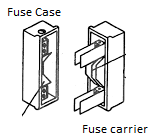
Fig 1 Kit Kat type Fuse
The fuse wire may be of lead, tinned copper, aluminium or an alloy of tin-lead. The actual fusing current will be about twice the rated current. The specifications for rewirable fuses are covered by IS: 2086-1963. Standard ratings are 6, 16, 32, 63 and 100A. A fuse wire of any rating not exceeding the rating of the fuse may be used in it i.e. a 80A fuse wire can be used in a 100A fuse, but not in the 63A fuse
Cartridge Type Fuses:
This is a totally enclosed type fuse unit. It essentially consists of an insulating container of bulb or tube shape and sealed at its ends with metallic cap known as cartridge enclosing the fuse element and filled with powder or granular material known as filler. There are various types of materials used as filler like sand, calcium carbonate, quartz etc. This type of fuse is available upto 660V and the current rating upto 800 A
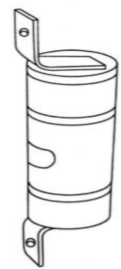
Fig 2 Cartridge Type Fuse
High Rupturing Capacity (HRC) Fuses:
With a very heavy generating capacities of the modern power stations, extremely heavy currents would flow into the fault and fuse clearing the fault would be required to withstand extremely high stresses in this process.
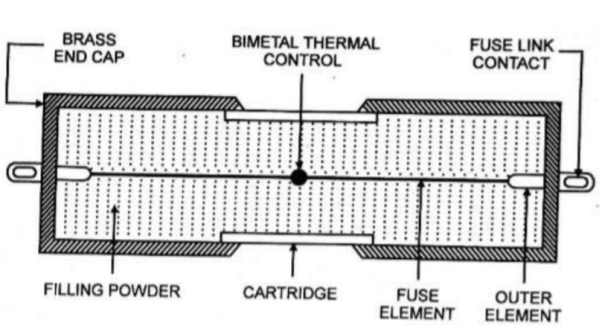
Fig 3 HRC Fuse
HRC fuses developed and designed after intensive research for use in medium and high voltage installations. Their rupturing capacity is as high as 500MVA up to 66 KV and above. There are basically two types of HRC fuses are used.
1. Cartridge Type HRC Fuse.
2. Tetra Chloride Type HRC Fuse.
Semiconductor Fuses: These are very fast acting fuses for protection of thyristor and other electronic circuits.
Switch Fuse Unit
It has one switch unit and one fuse unit. When the breaker is operated the contact to the switch is close and supply passes through the fuse unit to output. In fuse switch unit there is only fuse unit which acts as a switch. During operating the fuse unit closes the input and output of the breaker.
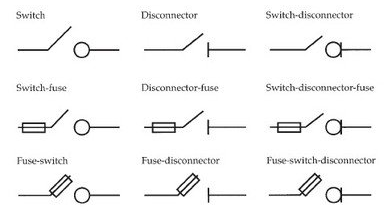
Switch fuse is a combined unit and is known as an iron clad switch, being made of iron. It may be double pole for controlling single phase two-wire circuits or triple pole for controlling three-phase, 3-wire circuits or triple pole with neutral link for controlling 3-phase, 4-wire circuits. The respective switches are known as double pole iron clad (DPIC), triple pole iron clad (TPIC), and triple pole with neutral link iron clad (TPNIC) switches.

Fig 4 SFU Switches
Switch Fuse Unit (SFU):
1. For Two-wire DC Circuits or Single Phase AC Circuits: 240V, 16A, DPIC switch fuse
2. For Three-Wire DC Circuits: 500V, 32A (63/100/150 or higher amperes), IS approved TPIC switch fuse.
3. For Three-Phase Balanced Load Circuits: 415V, 32A (63/100/150 or higher amperes), IS approved TPIC switch fuse.
Key takeaway
Fuse is provided only in phase or live pole, never on neutral pole.
MCB is a switch which automatically turns off when the current flowing through it passes the maximum allowable limit. Generally, MCB is designed to protect against over current and over temperature faults. In MCB there are two contacts one movable and other non-movable. When the current exceeds the predefined limit, a solenoid forces the moveable contact to open and the MCB turns off, thereby stopping the current from flowing in the circuits.
It mainly consists of one bi- metallic strip, one trip coil and one hand operated on-off lever. The current in MCB flows from left side of circuit to bimetallic strip further going into the current coil, moving contact and at last through right side of circuit. When circuit is overloaded the bimetallic strip is overheated.
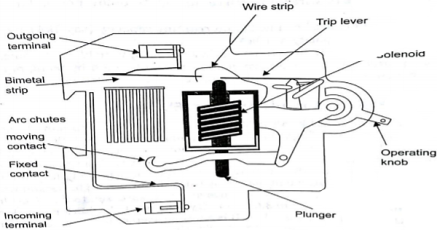
Fig 5 MCB
This deformation of bimetallic strip causes displacement in the latch. This displacement releases the spring through which the MCB is connected to the moving contact. This spring makes moving contact to open MCB.
The current coil or trip coil placed in such a manner that during SC faults, the MMF of that coil causes its plunger to hit the same latch point and force the latch to be displaced. Hence, the MCB will open in the same manner.
They are frequently used in domestic and industrial purposes. The MCB detects faults like switching, overload, short circuit protection and overload protection.
An Earth Leakage Circuits Breakers (ELCB) is a device used to directly detect currents leaking to earth from an installation and cut the power. There are two types of ELCBs:
(i) Voltage Earth Leakage Circuits Breaker (voltage -ELCB)
It consists of a relay coil; one end of that coil is connected to the metal body and other to the ground. When voltage on the equipment body rises to 50V (danger level) the current in the relay loop moves the relay contact by disconnecting the supply current and saves from electric shock.
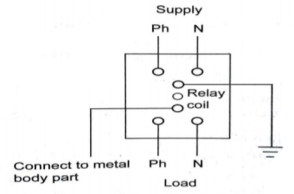
Fig 6 V-ELCB
(ii) Current Earth Leakage Circuits Breaker (Current -ELCB)
It is mostly commonly used ELCB. It consists of transformer having two primary (neutral and line wire) windings and one secondary winding. In balanced condition there is no current in secondary because the neutral wire balances the current through the phase wire.
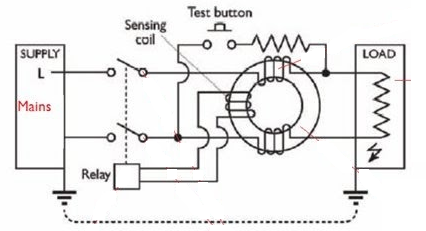
Fig 7 Current ELCB
During fault a small current flow to ground causing imbalance between line and neutral currents. As a result of which current is induced in secondary winding. The sensing circuit connected to the secondary sends signal to the tripping system and the contact is tripped.
Moulded case circuits breakers are electromechanical devices which protect a circuit from over current and short circuits. They provide over current and short circuits protection for circuits ranging from 63A up to 3000 A. They are used for heavy duty applications as they have high current ratings. They provide electric feeder protection, capacitor bank protection, generator protection, welding applications, low current application that require adjustable trip setting and motor protection.
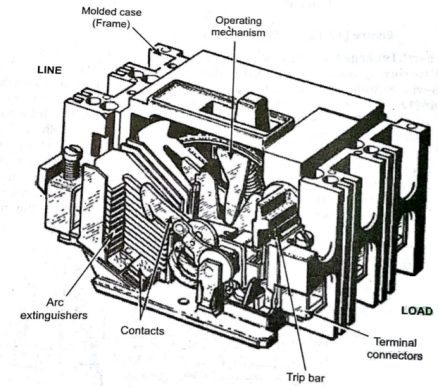
Fig 8 MCCB Circuit
The are made up of heavy duty insulated plastic. MCCB has a bimetallic contact that expands and contacts when there is change in temperature. When current exceeds the adjustable trip value the contact gets heated and expands. The fault currents in MCCB can be interrupted immediately. Whenever a fault occurs, the extremely high current induces a magnetic field in a solenoid coil located inside the breaker – this magnetic induction trips a contact and current it interrupted
Types of Cables
The wiresused for domestic or industrial wiring are classified into different groups as
(i) According to the conductor material used
(a) Copper conductor cables
(b) Aluminium conductor cable
(ii) According to number of cores
(a) Singles core cable (SCC)
(b) Double core or twin core cables (DCC)
(c) Three core cables
(d) Four core cables
(e) Two cores with earth continuity conductor cables
(iii) According to type of insulation
(a) Vulcanized Indian rubber (VIR) insulated wires/cables
(b) Tough rubber sheathed (TRS) or cable tyre sheathed (CTS) cables
(c) Polyvinyl chloride (PVC) cables
(b) Lead sheathed cables
(e) Weather proof cables
(f) Flexible cords and cables
(g) XLPE cables
(iv) According to the voltage at which they are manufactured
(a) Low tension (LT) cables – up to 1000V
(b) High tension (HT) cables – up to 11kV
(c) Super tension (ST) cables – from 22-33kV
(d) Extra high tension (EHT) cables – from 33-66kV
(e) Extra super voltage cables – beyond 132 kV
Types of Electrical Wiring Systems
The state electricity board provides the electric supply up to the outside the consumer’s premises. The consumer has to take the connection from that point to the main switchboard at home. From the main switchboard, various types of electrical loads such as fans, lights, room coolers, and refrigerators are connected through the wires. There are different types of wirings used for connecting the loads to the mains which can be used for house electrical wiring as well as industrial electrical wiring. Some of these are discussed below.
Cleat Wiring
In this, porcelain, wood or plastic cleats are fixed to walls or ceilings at regular intervals, i.e., 0.6 m between each cleat. PVC insulated cables are taken through the holes of each cleat and hence cleat support and holds wire. This is an inexpensive method of wiring and is used for temporary installations. Therefore, it is not suitable for home electrical wiring and also it is an outdated method.
Casing and Capping Wiring
In this cable is run through a wood casing having grooves. The wood casing is prepared in such a way that it is of a required fixed length with parallel grooves that accommodates the cables. The wooden casing is fixed to the walls or ceiling with screws. After placing the cables inside the grooves of casing, a wooden cap with grooves is placed on it to cover the cables. This is also a cheap wiring system, but there is a high risk of fire in case of short circuits.
Batten Wiring
In this, insulated wires are run through the straight teak wooden battens. The wooden battens are fixed on the ceilings or walls by plugs and screws. The cables are fitted onto the battens by using tinned brass link clips. These clips are fixed to the battens with rust-resistant nails. This wiring installation is simple and cheap as compared to other electrical wiring systems also takes less time to install. These are mainly used for indoor installations.
Conduit Wiring
In this wiring, PVC cables are taken through either PVC conduit pipes or through steel conduit pipes. This conduit wiring can be either surface conduit wiring or concealed conduit wiring. If the conduit pipes are run on surface of the walls and ceilings, it is called a surface conduit wiring. If the conduits are run inside the surface of the walls and ceilings and are covered with plastering, it is called as concealed conduit wiring.
Surface conduit wiring is used in industries to connect the heavy motors. On the other hand, concealed wiring is the most popular and common method of wiring the residential buildings. The conduit wiring is the safest method of wiring and also looks beautiful (concealed conduit wiring).
Earthing
It means connecting electrical equipment to earth with very low resistance wire. This ensures safe discharge of electrical energy due to failure of the insulation line coming in contact with the casing, etc. Earthing brings the potential of the body of the equipment to zero.
The main purpose of Earthing is to protect the operating personnel from shock. Under unbalanced load maintain the line voltage. To avoid risk of fire due to leakage currents. For protecting the equipment.
Methods of Earthing:
(i) Plate earthing: A copper plate of dimension 60cm x 60cm x 3.18 is used for earthing. The plate is buried in ground and layered with coal and salt. Then water is poured to maintain the earth’s electrode resistance below maximum value. The earth wire is bolted to the earth plate.
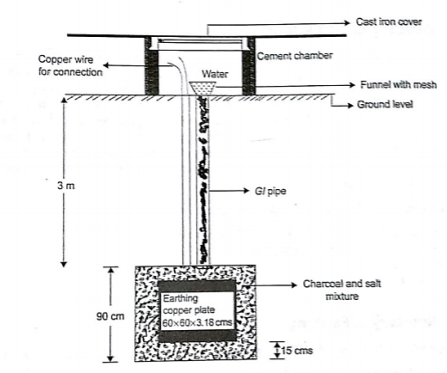
(ii) Pipe earthing:
The earth’s electrode made of galvanized iron pipe with holes on surface is placed upright in wet ground. In order to maintain the earth’s resistance, the pipe is filled with mixture of salt and coal.
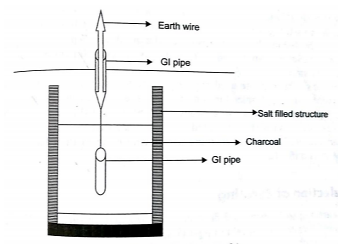
This system can carry larger leakage currents compared to plate earthing method.
(iii) Rod earthing: It is similar to pipe earthing method. A copper rod is buried upright in the earth manually or with pneumatic hammer. The length of embedded electrodes in soil reduces earth resistance to a desired level.
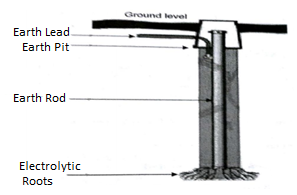
(iv) Strip or wire earthing: In this the earthing strip electrodes are buried in horizontal trenches of depth 0.5m. The copper plate or round conductors are used. The length of the conductor buried in the ground would give a sufficient earth resistance and this length should not be less than 15m. The electrodes shall be as widely distributed as possible in a single straight or circular trench radiating from a point. This type of earthing is used where the earth bed has a rocky soil and excavation work is difficult.
Application
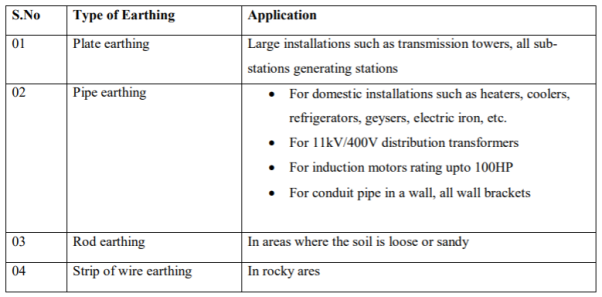
It converts chemical energy into electric energy. A combination of two or more voltaic cells is called as battery. Due to chemical reaction inside the cell voltage is produced. Electrodes are immersed in an electrolyte, which forces the electric charge to separate in the form of ions and free electrons.
i) Primary Batteries:
These are basically disposable batteries. They can be used only once. They are not rechargeable. EX. AA, AAA.
Types of Primary Batteries:
(a) Carbon- zinc dry cell: These are AA, AAA. They have zinc electrode as negative electrode and carbon as positive electrode. The output voltage of a single cell is about 1.5 V.
(b) Alkaline cell: It is AA type. It lasts long than carbon-zinc cell. It consists of a zinc anode and manganese dioxide cathode in an alkaline electrolyte
(c) Zinc chloride cell: These are heavy duty cells. It is modified zinc-carbon cell.
(d) Mercury cell: It is not used these days. It consists of zinc anode, mercury compound cathode and potassium or sodium hydroxide electrolyte.
(e) Silver oxide cell: This cell consists of a zinc anode, silver oxide cathode, and potassium of sodium hydroxide electrolyte. Normally used in cameras and watches.
(f) Lithium cell: It is light weight. It offers high output voltage. Two forms of 3V output in widespread use: (a) Lithium-sulphur di oxide (LiSO2). (b) Lithium- thionyl chloride.
Ii) Secondary Batteries:
These are rechargeable batteries. These are also called as storage batteries. They are rechargeable because the electric current reverses the chemical reaction inside the batteries that occurred during use. EX used in mobile phones, MP3 players.
Types of Secondary Cells:
(a) Lead-acid cell: It is most commonly used cell. It has porous lead anode and lead-oxide cathode. Used in automobile inverters. The output is of 2.1V.
(b) Nickel cadmium (NiCd) cell: It has Nickel hydroxide anode and cadmium hydroxide cathode. It delivers high current. It is used in cadmium hydroxide electrolyte. Used in alarm systems, TV equipment.
(c) Lithium-ion battery: It has graphite anode and lithium manganese dioxide cathode. The electrolyte used is mixture of lithium salts.
(d) Nickel-metal- hydride (NiMH) cell: They are used in power tools. They only have negative electrode, rest all similar to NiCd cells.
(e) Nickel-iron (Edison) cell: They have Nickel hydroxide anode and iron cathode with potassium hydroxide electrolyte. They are not in use now.
(f) Fuel cell: It converts chemical energy into water and produces electricity. They are used as source of DC power in space program. They are very efficient.
(g) Solar cell: They convert sunlight to electric energy. They are arranged in modules to form an array called solar array. An applied voltage higher than the voltage of one cell can be obtained by connecting cells in series. The total voltage available across the battery of cells is equal to the sum of the individual values for each cell. Parallel cells have the same voltage as one current capacity
Key takeaway
It converts chemical energy into electric energy. A combination of two or more voltaic cells is called as battery. Due to chemical reaction inside the cell voltage is produced. Electrodes are immersed in an electrolyte, which forces the electric charge to separate in the form of ions and free electrons.
The basic characteristics are:
i) Chemistry: Some batteries like lead, nickel and lithium need their own charger. So, the chemistry of the battery is important. It will not be properly charged if exact charger is not used.
Ii) Battery Capacity: It is the charge stored by the battery. y. The battery capacity represents the maximum amount of energy that can be extracted from the battery under certain specified conditions. The energy stored in a battery, called the battery capacity, is measured in either watt-hours (Wh), kilowatt hours (kWh), or ampere-hours (Ahr). The most common measure of battery capacity is Ah, defined as the number of hours for which a battery can provide a current equal to the discharge rate at the nominal voltage of the battery.
Iii) Voltage: Any battery has a nominal voltage. It is important to check the correct nominal voltage before use.
Iv) Cold Cranking Amps (CCA): Every starter battery is marked with cold cranking amps, also abbreviated CCA. The number denotes the amount of amps that the battery is able to provide at -180C.
The measurement of electrical energy depends on power. But
Power= Voltage x Current
Energy = Power x Time
Joule is the smallest unit of energy. Watt-hour is the standard unit used for measurement of energy.
Energy in watt hours = Power in watts × Time in hours
Energy in kilowatt hours = Power in kilowatts × Time in hours
This kilowatt hour is board of trade (BOT) unit.
Que) A consumer uses a 10 kW geezer, a 6 kW electric furnace and five 100 W bulbs for 15 hours. How many units (kWh) of electrical energy have been used?
Sol: Given that Load – 1 = 10 kW
Geezer Load – 2 = 6 kW
Electric furnace Load – 3 = 500 watt (five 100 watt bulbs)
Total load = 10kW + 6kW + 0.5kW = 16.5kW
Time taken = 155 hours
Energy consumed = Power in kW × Time in hours = 16.5 × 15 = 247.5 kWh
1 unit = 1kWh.
So, the total energy consumption = 247.5 units If the cost per unit is 2.5, then the total cost of energy consumption ̇=247.5 × 2.5 = 618.75/-
To calculate the consumption of an electrical appliance in kWh, you have to take into account three factors:
- The capacity of your electrical appliance, expressed in watt.
- The number of hours that the appliance is in use in one day.
- The number of days per year when the appliance is in use.
The calculation is as follows:
[number of hours’ use] x [number of days’ use] x ([capacity of appliance expressed in watt] / 1,000) = number of kWh
The capacity should be divided by 1,000 to convert the number of watts into the number of kilowatts. This finally gives us the number of kWh (kilowatt hours).
Que) A consumer uses a 10 kW geezer, a 6 kW electric furnace and five 100 W bulbs for 15 hours. How many units (kWh) of electrical energy have been used?
Sol: Given that Load – 1 = 10 kW
Geezer Load – 2 = 6 kW
Electric furnace Load – 3 = 500 watt (five 100 watt bulbs)
Total load = 10kW + 6kW + 0.5kW = 16.5kW
Time taken = 155 hours
Energy consumed = Power in kW × Time in hours = 16.5 × 15 = 247.5 kWh
1 unit = 1kWh.
So, the total energy consumption = 247.5 units If the cost per unit is 2.5, then the total cost of energy consumption ̇=247.5 × 2.5 = 618.75/-
Solved Examples Based on this Unit
Q1) Calculate the electricity bill amount for a month of 31 days, if the following devices are used: 3bulbs of 40W for 6hr, 4 tube-lights of 50W for 8hr and a TV of 120W for 6hr. Given the rate of electricity is Rs.2.50 per unit?
A1) It has been given that the following devices are used as specified 3bulbs of 40W for 6hr, 4 tube-lights of 50W for 8hr and a TV of 120W for 6hr.
Total power consumed by 3 bulbs = 40x3 = 120Wh=0.12kWh
Electrical units for 1 day = 0.12x6=0.72units
Electrical units for 31 days = 0.72 x 31 = 22.32 unis
Total Power the four tube-lights consume in a day = 50x4 = 200Wh=0.2kWh
Electrical units for one day = 0.2 x 8 =1.6 units
Electrical units for 31 days= 1.6 x 31 =49.60 units
Total power the TV consumes in a day = 120x6 =720Wh=0.720kWh
Electrical units for one day = 0.720x6 = 4.32units
Electrical units for 31 days = 4.32x31=133.92units
Total units consumed = Electrical units consumed by bulb for 31 days+ Electrical units consumed by tube-light for 31 days+ Electrical units consumed by TV for 31 days
= 22.32+49.06+133.92
= 205.84units
The rate per unit is given as 2.50 per unit. So, the total bill is = 205.84x2.50 = Rs 514.60
Q2) Calculate the electricity bill amount for a month of April, if 4 bulbs of 40 W for 5 h, 4 tube-lights of 60 W for 5 h, a TV of 100 W for 6 h, a washing machine of 400 W for 3 h are used per day. The cost per unit is Rs 1.80.
A2) Electric energy consumed per day by 4 bulbs = 4x40 x5 = 800Wh
Electric energy consumed per day by 4 lights = 4x60x5 =1200 Wh
Electric energy consumed per day by TV = 100x6 = 600 Wh
Electric energy consumed per day by washing machine = 400x3 =1200 Wh
.’. Total electric energy consumed by all electric appliances = (800+ 1200 + 600+
1200) Wh = 3800 Wh = 3.8 kWh =3.8 units
Total electric energy consumed in the month of April (30 days) = 3.8 x 30 =
114units
Cost of one unit = Rs. 1.80
Cost of 114 units = 114 x 1.80 =Rs 205.20
Electricity bill amount = Rs 205.20
Q3). A consumer has a maximum demand of 200 kW at 40% load factor. If the tariff is Rs. 100 per kW of maximum demand plus 10 paise per kWh, find the overall cost per kWh?
A3) Units consumed/year = maximum demand x load factor x hours in a year
= (200x0.4) x 8760 = 7,00,800 kWh
Annual charges = Annual M.D charge+ Annual Energy charges
= Rs(100x200+0.1x700800) = Rs. 90,080
Overall cost/kWh = Rs90080/700800 = Rs 0.1285 = 12.85 paise.
Q4). The maximum demand of a consumer is 20 A at 220 V and his total energy consumption is 8760 kWh. If the energy is charged at the rate of 20 paise per unit for 500 hours use of the maximum demand per annum plus 10 paise per unit for additional units, calculate: (i)annual bill (ii) equivalent flat rate.
A4) Let load factor and power factor be unity
Maximum demand = (220x20x1)/1000 = 4.4kW
Units consumed in 500hrs = 4.4 x 500 = 2200kWh
Charges for 2200kWh = Rs 0.2 x 2200 = Rs 440
Remaining Units = 8760-2200 = 6560kWh
Charges for 6560kWh = Rs 0.1 x 6560 =Rs 656
Total annual bill = Rs (440+656) = Rs 1096
Equivalent flat rate = 1096/8760 = Rs 0.125 = 12.5 paise
Key takeaway
1 unit of electricity means 1kWh of electricity consumption which is the unit of electrical power.
The term power factor comes into the picture in AC circuits only. Mathematically it is the cosine of the phase difference between the source voltage and current. It refers to the fraction of total power (apparent power) which is utilized to do the useful work called active power.
Cosɸ = Active power/ Apparent power
- Real power is given by P = VIcosφ. The electrical current is inversely proportional to cosφ for transferring a given amount of power at a certain voltage. Hence higher the pf lower will be the current flowing. A small current flow requires a less cross-sectional area of conductors, and thus it saves conductors and money.
- From the above relation, we see having poor power factor increases the current flowing in a conductor and thus copper loss increases. A large voltage drop occurs in the alternator , electrical transformer and transmission and distribution lines – which gives very poor voltage regulation.
- The KVA rating of machines is also reduced by having higher power factor, as per the formula:
KVA = KW/ cos ɸ
Hence, the size and cost of the machine is also reduced.
References:
- D. P. Kothari and I. J. Nagrath, “Basic Electrical Engineering”, Tata McGraw Hill, 2010.
- D. C. Kulshreshtha, “Basic Electrical Engineering”, McGraw Hill, 2009.
- L. S. Bobrow, “Fundamentals of Electrical Engineering”, Oxford University Press, 2011.
- E. Hughes, “Electrical and Electronics Technology”, Pearson, 2010.
- V. D. Toro, “Electrical Engineering Fundamentals”, Prentice Hall India, 1989.